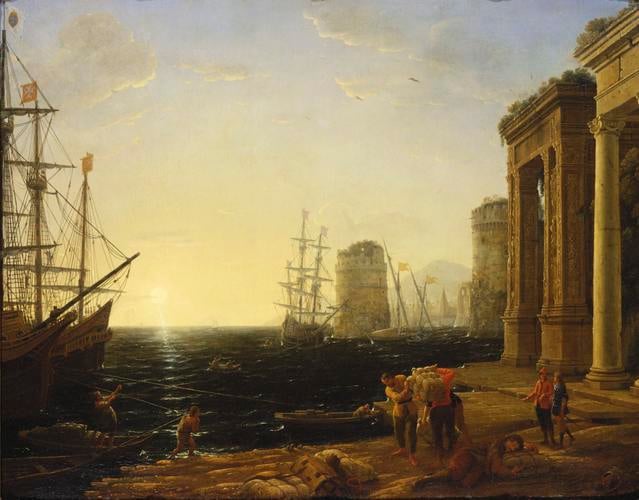-
1 of 253523 objects
Harbour Scene at Sunset Inscribed 1643
Oil on canvas | 74.3 x 99.4 cm (support, canvas/panel/stretcher external) | RCIN 401382
-
Claude (1604/5-82) was born in the Duchy of Lorraine, which was then an independent state within the Holy Roman Empire. He travelled to Italy in 1613 and studied with the Italian perspective specialist and landscape painter, Agostino Tassi. By 1627 he had settled in Rome in the ‘artists’ quarter’, where he remained for the rest of his life.
Claude’s first mature works, like his landscape of 1638 in Minneapolis Institute of Arts take as their point of departure the landscape of Poelenburgh, especially in their ‘stage management’. However, Claude’s Campagna is a fertile paradise with ruins rather than a scorched earth, his observation of light so subtle that it is as if he paints the vapour hanging over every surface rather than the surface itself. Scenes such as this struck Claude’s contemporaries as miracles of naturalism, not idealisation: in his Academie of 1675 Sandrart described a Claude painting ‘in which one can truly recognise how the sun, risen for some two hours above the horizon, dissipates the nebulous air and how the dew floating upon the waters really mingles astonishingly with it’; the Florentine, Filippo Baldinucci, asserted in his Notizie de’ Professori del Disegno (published 1681–1728) ‘that the great quality of this artist was a marvellous and still unsurpassed imitation of nature in those of its various aspects which condition the views of the sun, particularly on the sea and the rivers at dawn and evening’.
This harbour scene approaches Roman ruins with the same wonderment that Claude approached the Campagna: in reality the Arco degli Argentieri (Arch of the Money-Changers) was in a squalid corner of Rome, but here it is the glorious frame of an idealised harbour with a walled port in the background, protected by two venerable towers. The activities of the figures similarly seem to be calculated to create a mood rather than describe the Italian street: two noble figures contemplate a voyage, while bales of cloth and caskets of treasure are unloaded and a man sleeps (associating the setting sun with well-earned repose).
Claude’s other strength, acknowledged by his biographers, was his command of perspective: here a strict vanishing point dictates the perspective of the comfortably solid architecture and pavement. The sun also sets on the vanishing point and every part of the tone and colour of the painting is dictated by its distance from this point. The sky describes a spectrum of yellow to blue and light to dark, but the transitions are so imperceptible and the range so remarkably close that it appears to be no more than an inflection within a single white glow. The colour separation of evening produces exactly this effect: the sky appearing yellow as one faces the sun and blue as one turns away from it; Claude suggests that his painting covers but a small part of the larger hemisphere of the sky. The air at evening also appears mistier as one looks into the sun and clearer as one looks away, an effect which Claude also records with great fidelity, making his lit surfaces at the margins sparkle sharply against the blue sky behind while at the same time veiling the central areas surrounding the sun with a glowing mist. The only part of the scene out of step with this tonal shift is the intensely dark sea, which accurately records the appearance of deep water seen at twilight, but which also suggests the Homeric epithet ‘the wine-dark sea’.Provenance
Probably acquired by Frederick, Prince of Wales; recorded at Buckingham Palace in the King's Dressing Room in 1785 and in the Blue Room in 1819
-
Creator(s)
Acquirer(s)
-
Medium and techniques
Oil on canvas
Measurements
74.3 x 99.4 cm (support, canvas/panel/stretcher external)
101.3 x 120.7 x 8.2 cm (frame, external)
Alternative title(s)
Seascape with ruins
A seaport with ruins

